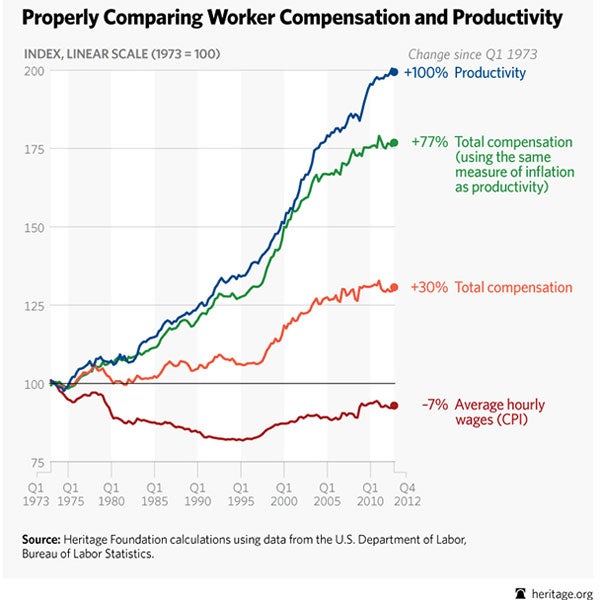Paul Krugman and many others argue that compensation has not grown as fast as productivity. However, most of the apparent gap between the growth of pay and the growth of productivity is a statistical illusion.
On the surface, the numbers appear to show pay and productivity diverging. Hourly wages have fallen slightly since the early 1970s, while productivity has doubled. But these appearances are deceiving. Consider that “pay” is a loose term: Employers pay workers with both cash wages and benefits, which have grown rapidly over the past generation. Part of the gap comes from ignoring this part of workers’ “unofficial salary.”
Nor is “figures adjusted for inflation” a sufficient footnote. Using different measures of inflation to adjust productivity and compensation produces different results. The Bureau of Labor Statistics (BLS) uses the Implicit Price Deflator (IPD) to adjust productivity for inflation. Most analysts use the Consumer Price Index (CPI) to adjust compensation. However, for methodological reasons the CPI estimates higher inflation; it amounts to an apples-to-oranges comparison. Using the IPD to adjust compensation shows average hourly compensation growing 77 percent over the past generation.
Much of the remaining gap comes from overestimating productivity growth. The rate at which investments depreciate has increased since computer and software use became widespread in businesses. Economist Dean Baker has pointed out that “no one can eat depreciation.” This “inedible” depreciation inflates the gross productivity growth figures that the BLS reports.
Taking these factors into account shows that compensation has grown in step with productivity. However, despite productivity growth, many workers have not seen their pay increase. This has happened because less-skilled workers have benefited far less from the technological advances that have raised the productivity—and pay—of highly skilled employees. Civil engineers and architects can now use software to rapidly visualize designs. However, it takes as many people to change sheets in a nursing home today as it did before.
Calls to reconnect “worker pay” and productivity are based on mistaken comparisons of economic data. Policymakers should instead focus on ways to make all workers more productive. Reducing the cost of higher education—such as innovations in online education—would help workers become more productive and command higher pay. That would do far more to help them than hand-wringing over a statistical illusion.

